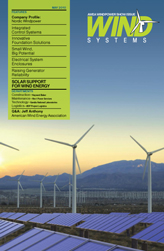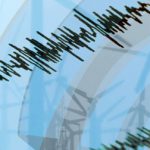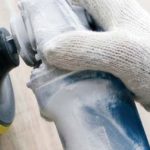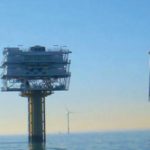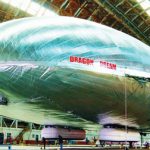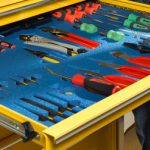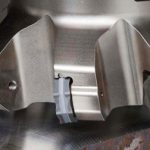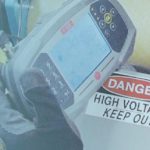Whether it is carbon based, nuclear, or alternative energy, production availability and equipment reliability are crucial issues for any power generation facility. For wind energy operations, managing multiple turbines in remote locations complicates how these goals are attained. Even with improved SCADA information, critical performance indicators are often recognized too late for any action beyond watching the generator fail.
This article will identify some of the actions owners or operators of wind generation systems can take to extend the life of their assets. Proper periodic maintenance and field data analysis—as well as winding design and other improvements while in a service facility—contribute to the safe, reliable performance of a wind generator throughout its lifecycle.
Field Lessons
The owners of a wind power system have invested millions of dollars in capital equipment. To keep their venture paying back they must maintain and service the equipment as required per the manufacturer’s recommendations—at a minimum. In saying that, there are additional “best practices” recommended in consensus industry standards.
Having a savvy and qualified field service group servicing your equipment is of the utmost importance, which will increase the life of generators and other related components. Because these machines can be complex, managing common service items as well as unforeseen issues on a daily basis means the difference between acceptable uptime and unprofitable downtime. So, what maintenance philosophy should be used to maximize the return on investment and increase reliability? Let’s begin with a discussion about the applications for preventive and predictive maintenance.
Preventive/Predictive
A combination of both preventive maintenance (PM) and predictive maintenance (PdM) go hand in hand when best practices are implemented within wind generator fleets. Preventive maintenance techniques would typically be performed on carbon brushes, slip ring assemblies and the cleaning of internal generator components, etc. Predictive maintenance techniques would be used to circumvent possible mechanical and electrical failures of the wind generators by performing tasks such as vibration analysis, infrared thermography and monitoring electrical conditions.
Driving a car to and from work every day with the expectation of reliability and many years of service requires maintenance on a continuous basis, both preventive and predictive. The same is true of a generator fleet. Critical testing and maintenance tasks collected from many years of experience in servicing wind generators are identified in Table 1 and Table 2. Following these basic guidelines will result in quicker return on investment by creating greater system reliability and longer service life.
It should be noted that the tasks outlined in Table 1 require the unit to be offline and de-energized. Because electricity is a highly toxic substance, only properly qualified and experienced personnel should be asked to perform these tasks. Technicians must be able to identify the hazards associated with their jobs (Figure 1) and receive the proper training and documented education to be considered qualified.
The second set of tasks outlined in Table 2 require even more experience and higher levels of qualification, since they involve energized and rotating components. Electric shock, arc flash, and mechanical hazards are all very real and prevalent during the process of performing these tasks. Don’t take shortcuts on personnel training or work practices, because the results may be disastrous. These requirements should extend to on-site personnel and all outside contractors. Both must be qualified and properly trained.
Preventive maintenance techniques can help prevent common failures such as shorted or faulted slip rings due to excessive carbon build up or insulation failure, and predictive maintenance techniques can help predict common failures such as the electrical fluting of bearings. Using these various techniques can help with decision-making related to the frequency of testing and planned maintenance outages (see note, Table 1), and also help prevent a catastrophic generator failure.
Speaking of testing frequency, many factors must be considered when scheduling the work associated with the servicing of machines in the field. The idea is to perform scheduled maintenance and servicing as needed, but not too often or too little. Factors that affect the decision-making process include items such as equipment criticality and device significance, current condition, lubrication life, maintenance history, operational history, industry experience, maintenance philosophy, operating environment, time allowed for maintenance, and the manufacturer’s recommendations.
Service Center Lessons
Just like field services, utilizing a quality service center will help increase the life of your generator and help assure wind park productivity. When evaluating a service center there are many important criteria. At a minimum, the service center should be a member of the Electrical Apparatus Service Association (EASA) and perform repairs in accordance with the ANSI/EASA Standard AR-100, Recommended Practice for the Repair of Rotating Electrical Apparatus. Not only is being a member of EASA important, but having a Quality Management System (QMS) and being ISO certified are additional criteria to look for when evaluating a service center. Some of the highlighted requirements for service centers are shown in Table 3.
When generators find their way into a service center for repairs it is normally due to mechanical or electrical failures while in service. There are many lessons to be learned from the service center’s failure analysis procedures if they have a QMS program in place. Evaluating the failure data can provide valuable information for the balance of your fleet. It’s the “learn from your mistakes” effect that oftentimes pays back many times over. Improper lubrication, inadequate ventilation, brush grades and slip ring material choice, etc., can all contribute to failures, but if these are not identified at the initial inspection they are often missed.
Extending Generator Life
Wind generators come in all sizes and ratings, and the designs of these units certainly vary among manufacturers. They have one thing in common, however: they all eventually fail. A wind generator’s life can be influenced by ensuring that the best-possible processes and procedures are in place during a shop repair.
When a wind generator has failed much time, effort, planning and money are needed to remove the generator from the wind-farm site and ship it to a qualified repair facility. Once the repair facility receives the generator and inspects the unit after disassembly they can normally recognize what repairs are needed. However, what is crucial at this stage is understanding why the machine failed. This critical point of the inspection process—the root cause failure analysis—is often left out, or forgotten. Corrective actions must be taken at this point.
Examples of the root failure causes include improper grease in a given unit, the breakdown of wire strand insulation due to heat over a long period of time or even improperly sized cable. Poor craftsmanship from a manufacturer or repair shop could be a culprit, as well. There are many possibilities that can lead to failure and, again, this must be investigated so corrective action can be put into process on the front end of the repair cycle.
As mentioned earlier, qualifying a repair shop is an essential part of the repair process and is detailed in Table 3. One additional item to look for in particular is the working area where the repair of the windings will be performed. When installing the windings in a wind generator, care must be taken and the condition of the work area must be considered. A climate- and condition-controlled winding area, or winding bay, should be a high priority for any repair facility to ensure the best possible results can be attained for the rewind of a wind generator. Any dust or foreign debris within a stator or rotor during the rewind process can cause serious problems for the generator once placed back in service, so contaminants need to be avoided.
Insulation System
The most-costly components of a wind generator repair are the electrical windings of the rotor and stator. Manufacturers mass produce wind generators, and many use the minimum insulation required. For example, many manufacturers still use class F (155° C rating) material for the insulation system in the stator or rotor windings. Heat developed during the operation of a wind generator is detrimental to stator and rotor winding insulation life. It is generally accepted that every 10° C rise in temperature will result in a halved life expectancy of the insulation. A simple upgrade to class H system (180° C rating) will enable the repaired wind generator to operate at a higher temperature with little additional cost (Figure 2). The entire insulation system and methods of application should be equal or better to the original machine manufacturer. All components of the insulation system must be compatible with each other with respect to electrical, mechanical, and thermal characteristics. At the end of the day, the insulation system should withstand the normal operational requirements of the machine, as well as necessary over-potential tests performed at the service center.
Operating Speed
Many manufacturers originally designed their wind generators to operate at 50 Hertz. In the United States, the wind generators operate at 60 Hertz. It is imperative the fiberglass bands used to control rotational forces on rotors will accommodate the speed increase caused by 60-Hertz systems. A mathematical formula can be obtained to calculate the amount of banding material needed from organizations such as EASA. Another important aspect is to balance the rotor while at the service center (Figure 3).
Conductor Type
The conductor (or magnet wire) strand insulation is vital for the life of any repaired wind generator, as it is the primary insulator for the winding circuits. There are many different types of polymers and enamels for the wire insulation. Some materials may be very resistant to voltage spikes but susceptible to mechanical stress, while other types may be very tough mechanically but difficult to install. Additionally, some types of wire are very costly and are not beneficial to use. Choosing the proper wire strand insulation to be used can be difficult, but it is essential for the extended life of a repaired wind generator. It would benefit any end user of a repaired wind generator to be involved in deciding which type of wire insulation to use in this part of the process.
Processing
Assuring proper spacing and clearances, correctly impregnating resin and bracing winding end turns is often overlooked. Airflow can be blocked around end turns, causing unwanted higher temperatures. This can lead to premature failure on any repaired wind generator. Additionally, vibrations of wire strands not bundled as a solid mass or without proper resin impregnation can also lead to premature failures. Many times this common mistake is made when a failure analysis is not properly conducted. Care must be taken when adding additional components to stiffen the winding end turns, because additional insulation uses more space (Figure 4).
Insulating Resin
The resin treatment of winding used in wind turbine generators should be done utilizing a vacuum pressure impregnation (VPI) system. Many wind generators have very long bores compared to the inside diameter of the stator or rotor core. Properly processed, the appropriate resin will penetrate and fill the slots of a rotor or stator, and it will also create solid end turns that can dissipate heat more readily.
Summary
While this article highlights some of the key lessons from the field and the service center, the central message is to be involved with the service and repair process, pre-qualify service providers, and make sure all of the work is done safely. Uptime availability is important, and extending the life of generators will lead to higher performance values and greater financial returns.



















